Tips for Container Gardening in a French Garden: Simple Ideas for a Charming Space
Creating a beautiful container garden with French flair can be a delightful and rewarding project. You can transform any outdoor space into a charming, stylish retreat by following a few simple tips. Whether you have a sprawling backyard or a cozy balcony, the elegance of French garden design can be achieved with thoughtful plant selection and container placement.
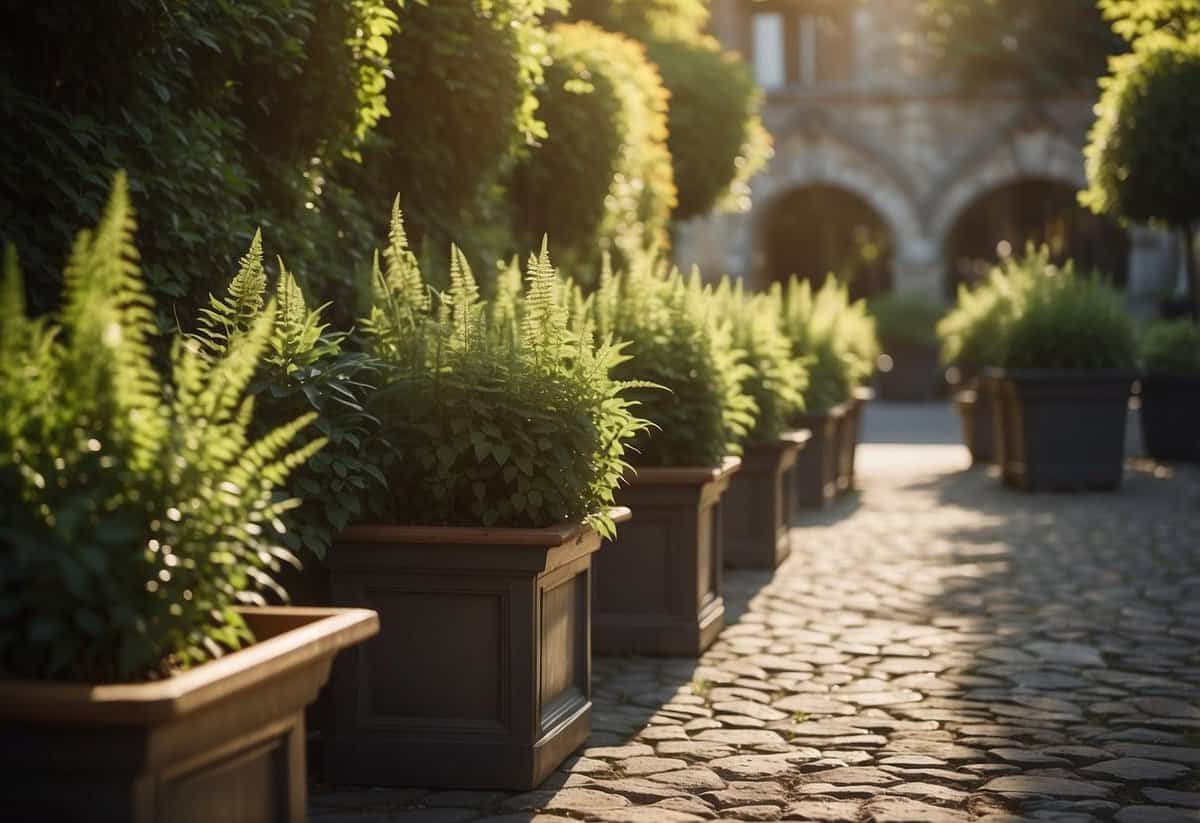
From vibrant flowers to aromatic herbs, container gardens offer flexibility and creativity. The right combination of plants will create a picturesque setting that exudes the timeless beauty of the French countryside. Decorate your space with vintage urns, rustic pots, and elegant water features to complete the look.
1) Use Terracotta Pots
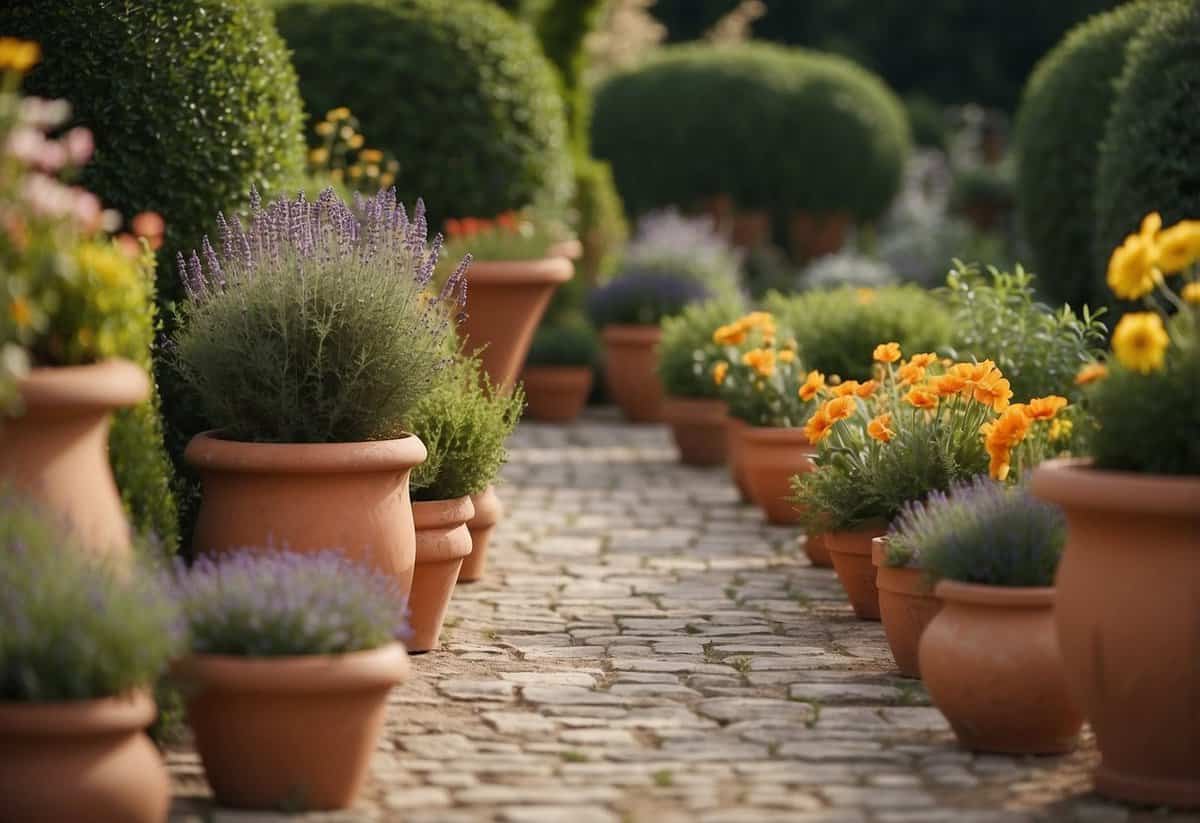
Terracotta pots are a great choice for container gardening in a French garden. These pots have a natural orange-brown color, adding a rustic charm to your space.
Terracotta is porous, allowing water and air to pass through. This helps prevent overwatering, which is helpful for many plants.
Before planting, soak your terracotta pots to ensure they don’t pull moisture from the soil. This step will keep your plants healthy and thriving.
For more tips on using terracotta pots, check out Gardening Know How.
2) Plant Lavender Along Pathways
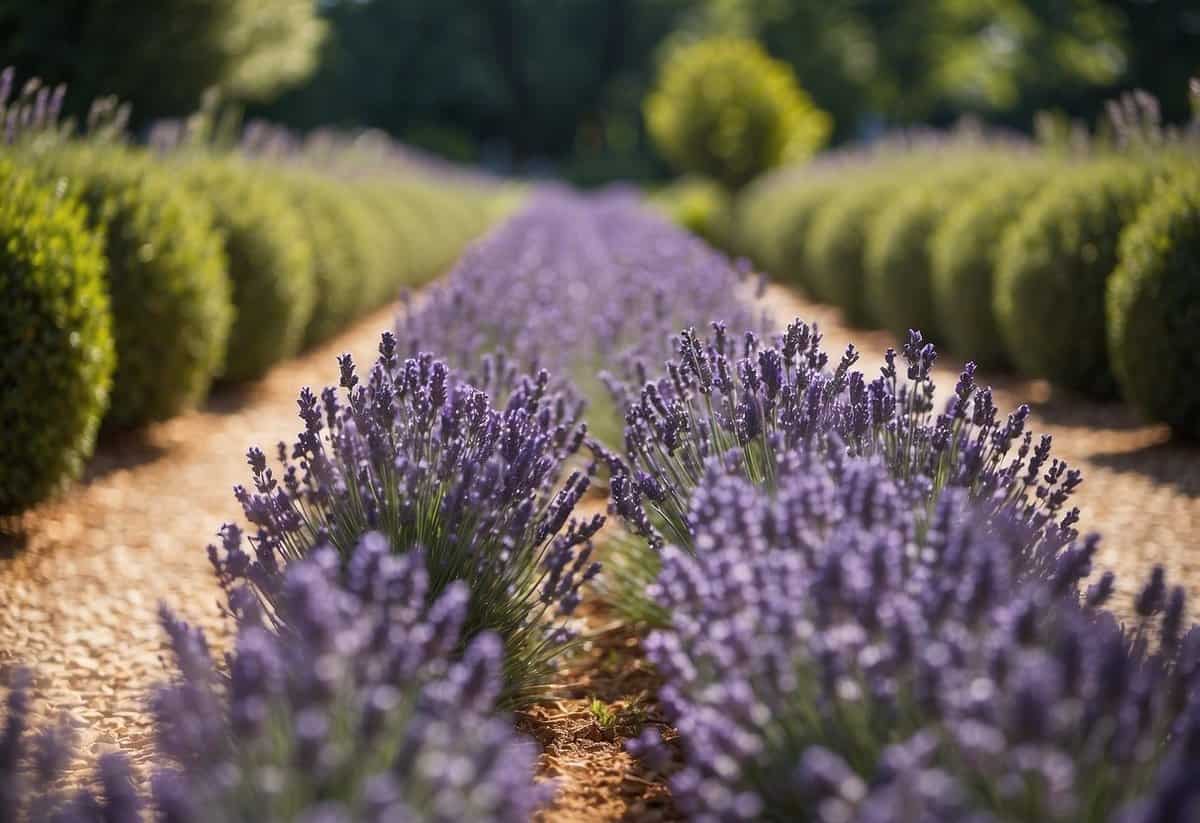
Planting lavender along pathways brings a delightful fragrance to your garden. Choose a sunny spot as lavender thrives in full sun.
Pick container-friendly varieties like French lavender, known for its longer blooming period. Make sure the soil in the pots drains well to avoid root rot.
Place the lavender pots along the edges of your pathways. This setup not only looks beautiful but also makes walking through your garden a sensory experience.
Utilize Small Shrubs Like Boxwood

Small shrubs like boxwood are perfect for a French garden. They add structure and elegance.
Boxwoods thrive in containers, making them versatile for your patio or balcony. They maintain their rich green color throughout the year.
Consider using Green Velvet for a compact and lush look. Enjoy their classic appeal and easy maintenance in your French garden.
4) Incorporate Climbing Roses
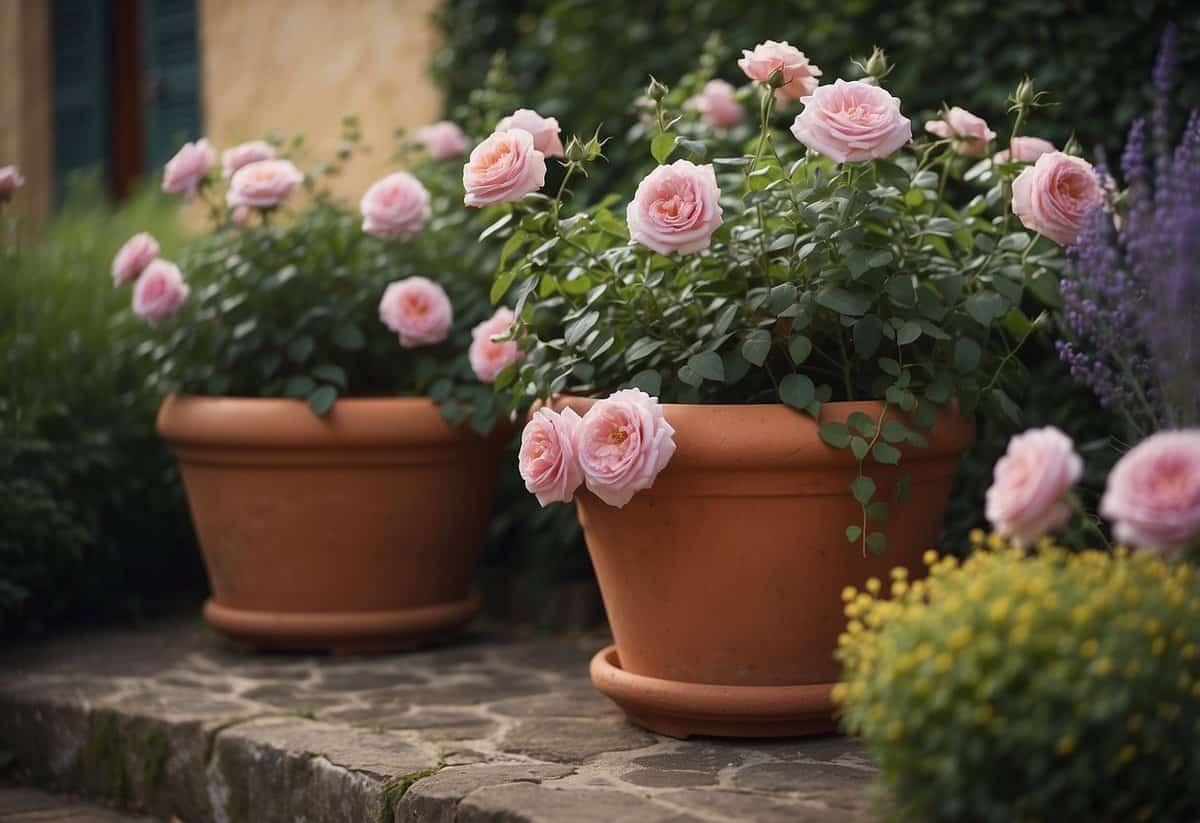
When adding climbing roses to your container garden, choose varieties that do well in pots. Small English climbing roses are great options.
Ensure the container is large enough to allow root growth. Place the pot where it gets plenty of sunlight, as roses need at least 50% sun daily.
Remember to mulch during summer. This keeps the soil cool and helps retain moisture. In winter, protect the rose crowns to ensure they thrive through the cold season.
By following these steps, your climbing roses will flourish beautifully in your French garden.
5) Grow Herbs in Tiered Containers

Growing herbs in tiered containers can save space and add a charming look to your French garden.
Choose herbs that thrive together, such as basil and parsley, which enjoy consistent moisture.
Make sure the bottom layer has good drainage to prevent waterlogging, which is important for the health of your herbs.
Place your tiered containers in a spot that gets full sun for at least six to eight hours daily. Proper sunlight ensures vibrant and healthy growth.
Arrange herbs like thyme and cilantro in the top tiers, where they can cascade over the edges gracefully. For more tips, check out this guide on growing herbs in containers.
6) Install a Drip Irrigation System
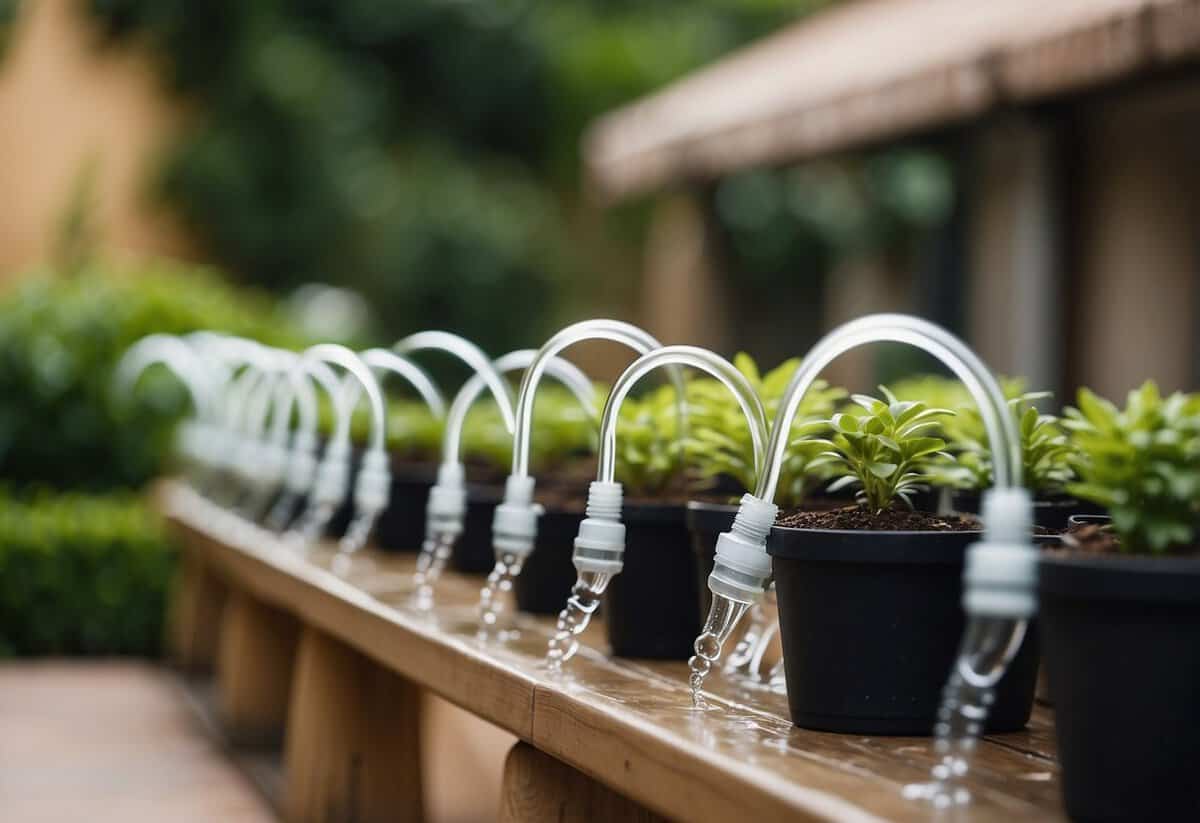
Drip irrigation is perfect for container gardening in your French garden. It saves water and makes sure your plants get the moisture they need.
You will need tubing, connectors, and a timer. Use ¼ inch tubing for most setups, but if you have larger containers, ½ inch tubing might work better.
Connect the tubing from your water source to each container. Secure it with connectors and ensure it’s tight. Setting up a timer will automate the watering process, so you don’t have to worry about it daily.
For more details, you can check out how to set up drip irrigation for pots.
7) Choose Plants Native to France
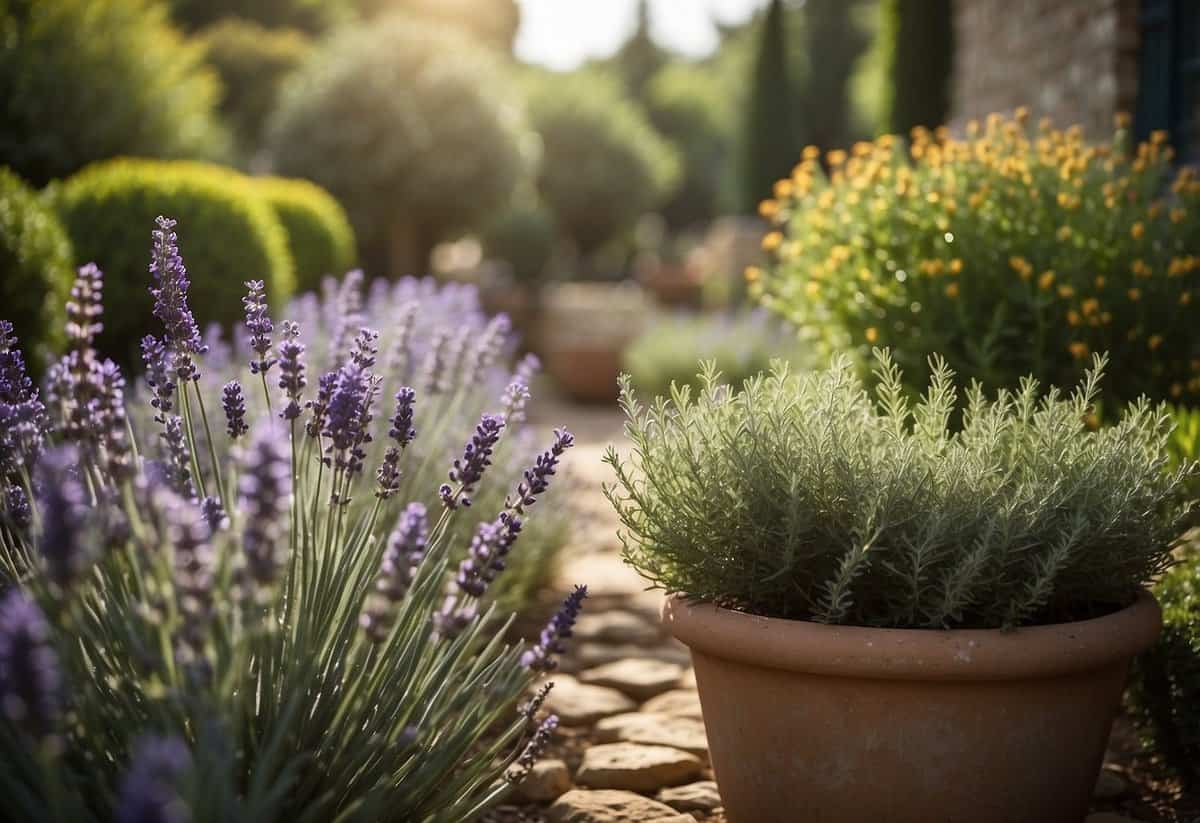
Choosing plants native to France for your French garden can make it more authentic. Lavender, for instance, is fragrant and beautiful. It’s perfect for adding a touch of Provence.
Rosemary is another great choice. It grows well in the climate and adds a lovely aroma.
Finally, consider thyme. This herb is easy to grow and versatile in cooking.
8) Arrange Potted Plants in Groups
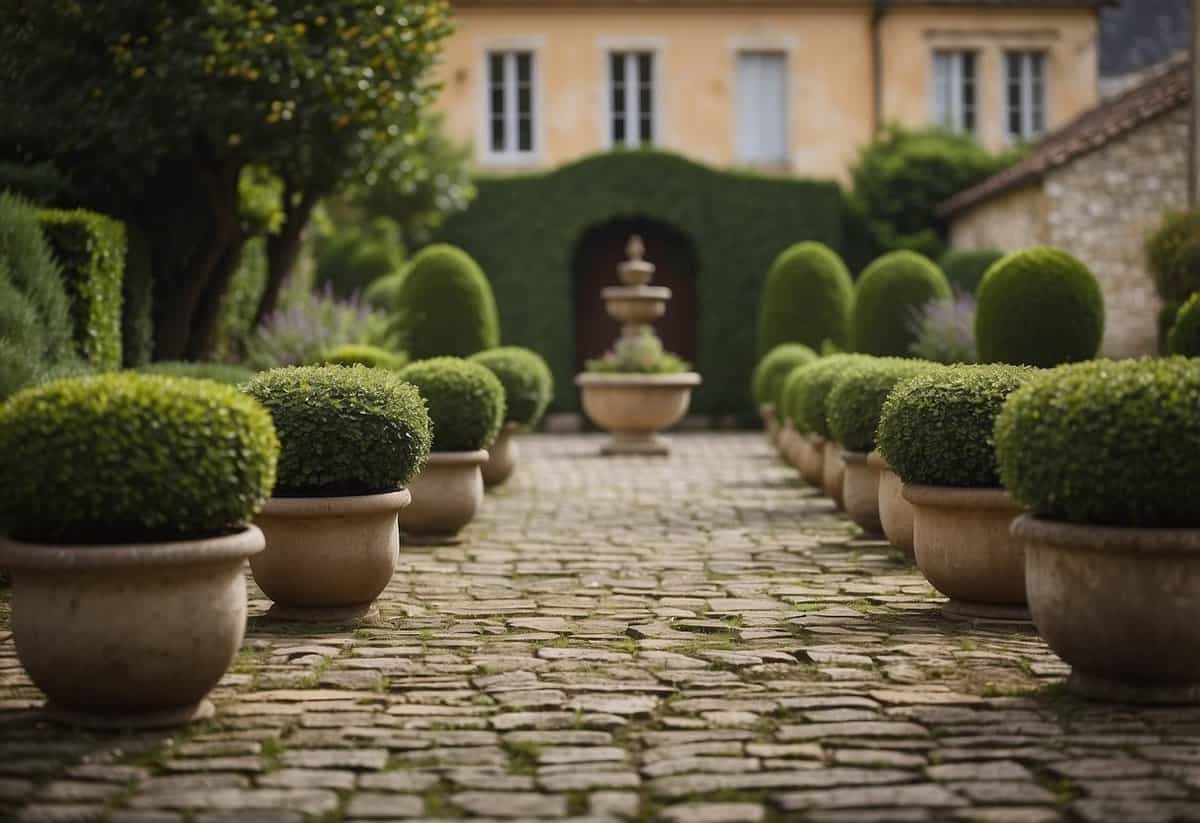
Grouping your potted plants can transform your French garden. Start by picking a mix of tall, medium, and short plants. For example, use taller cacti or sago palms with medium-sized plants like snake plants, and fill in gaps with short succulents.
Place taller plants in the back and shorter ones in the front to create depth. Combining plants with different textures and colors adds visual interest and harmony. For more ideas, you can check out these potted plant arrangement ideas.
9) Plant Thyme Between Pavers

Planting thyme between pavers can add a lovely touch to your French garden. Choose a variety like creeping thyme that spreads well. Make sure the soil or sand between the pavers is loose.
Water thoroughly after planting to help the thyme settle. Be patient; it can take a few seasons for thyme to fill the gaps completely. For more details, check out how to plant thyme between pavers.
10) Add a Small Citrus Tree
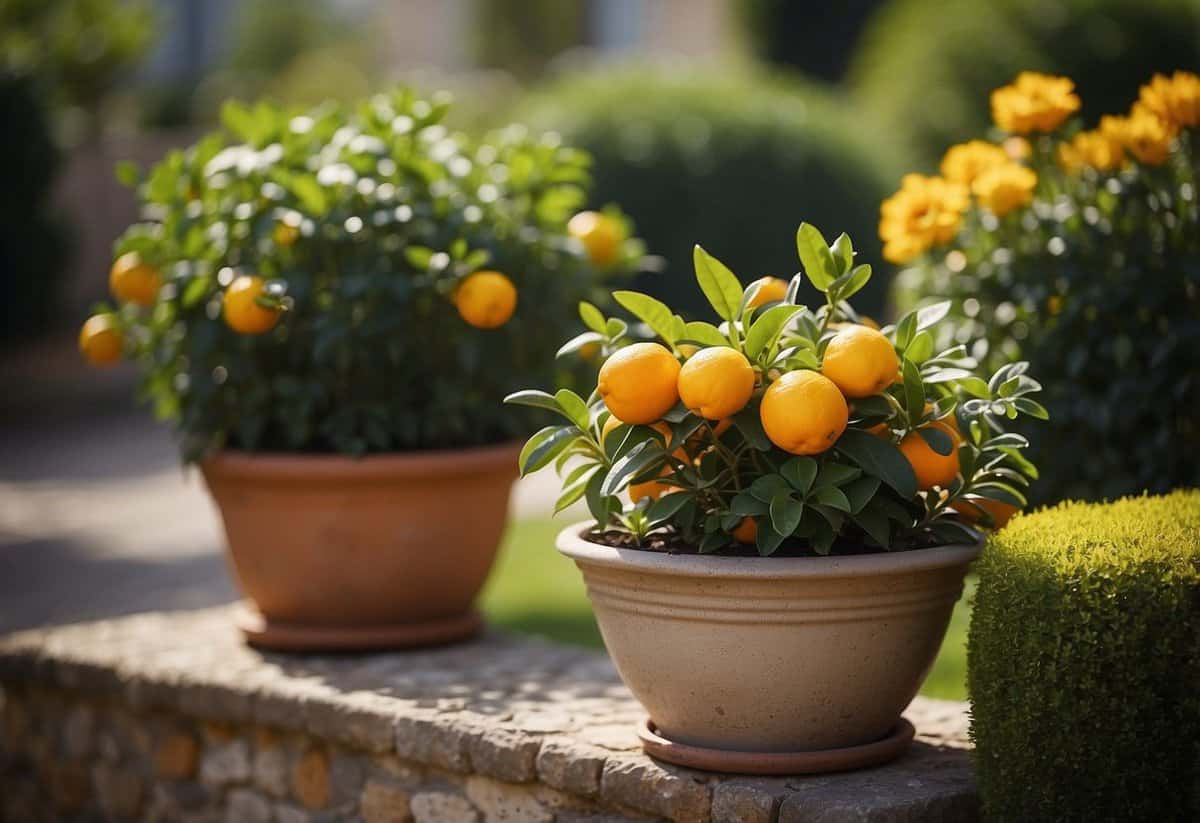
Adding a small citrus tree to your container garden brings both beauty and practicality. Citrus trees, like the Yuzu, are perfect for pots and can grow up to 4-6 feet tall.
Place your tree in a sunny spot. Citrus trees need 8 or more hours of direct sunlight to thrive. Use a container twice the size of the nursery pot to allow roots room to grow. A half whiskey barrel or large terra cotta pot works well.
Understanding French Garden Aesthetics
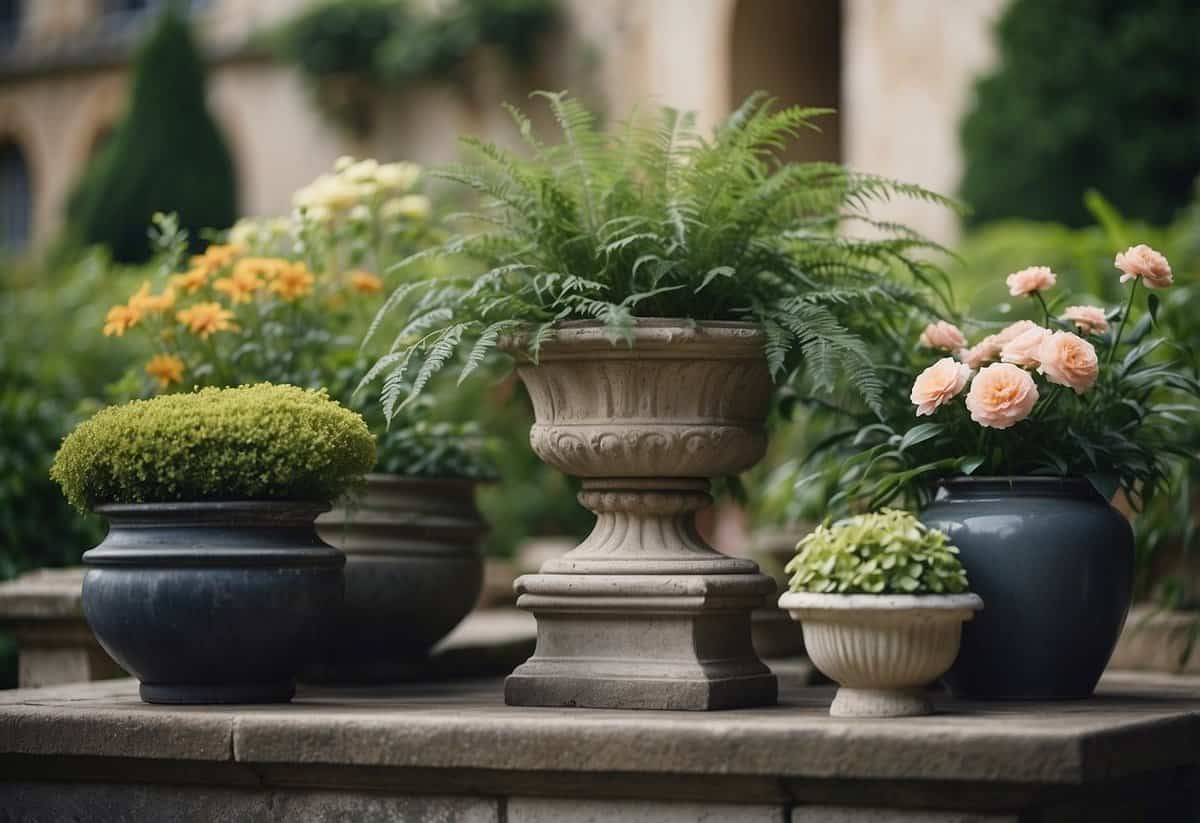
French garden aesthetics combine historical elegance with meticulous design principles. These gardens focus on symmetry, balance, and the harmonious blend of nature and man-made elements.
Historical Significance
French gardens have a long history that dates back to the Renaissance. Influenced by classical architecture, these gardens emphasize order and precision. Notable examples include the gardens at Versailles, which showcase the grandeur and formal style typical of French garden design.
During the 17th century, André Le Nôtre became a prominent figure in garden design. His work at the gardens of Versailles demonstrated the importance of geometrical layout and symmetry. Le Nôtre’s designs were widely imitated and helped to establish the standard for French garden aesthetics.
Essential Design Principles
Symmetry and balance are key elements. Gardens are often laid out in geometrical patterns, with pathways, hedges, and flower beds arranged to create pleasing proportions. This structured approach helps instill a sense of order and calm.
Using a mix of materials, like stone or gravel pathways, helps to add texture and contrast. Terracotta pots and aged metal containers contribute to the rustic charm. Incorporating natural elements such as lavender, roses, and boxwood creates a lush and inviting environment.
Carefully selected plants, arranged to complement each other, can enhance the overall look. Consider planting classics like hydrangeas and rosemary. These plants not only look beautiful but also thrive in the French climate, ensuring your garden remains vibrant and healthy.
Choosing the Right Containers

Selecting appropriate containers is crucial for a thriving French garden. Focus on the material, size, and shape of the containers to create a healthy environment for your plants.
Material Selection
The material of your containers can greatly affect the success of your garden. Terracotta pots are excellent for Mediterranean plants like lavender, as they provide good drainage. Wood is ideal for both hot and cold climates and blends well with various garden styles.
Fabric grow bags are another versatile option, especially if you plan on moving your plants. They allow for better air circulation and root health. While metal or fiberglass containers are best for longevity, they may require more attention in terms of temperature regulation.
Each material has its own pros and cons, so choose based on your specific plant needs and local climate.
Size and Shape Considerations
The size and shape of your containers play a crucial role in your garden’s success. Opt for containers that are at least 12 inches in diameter and depth for most vegetables. Corn, for example, needs at least four plants per container, growing best when spaced four to six inches apart.
For herbs and smaller plants, narrower containers can suffice but ensure they still offer ample room for root growth. Rectangular boxes are perfect for small rows of lettuce or spinach, while deeper pots are essential for root vegetables like carrots and potatoes.
Proper drainage is also important. Ensure containers have holes at the bottom to prevent waterlogging.
Plant Selection for a French Garden
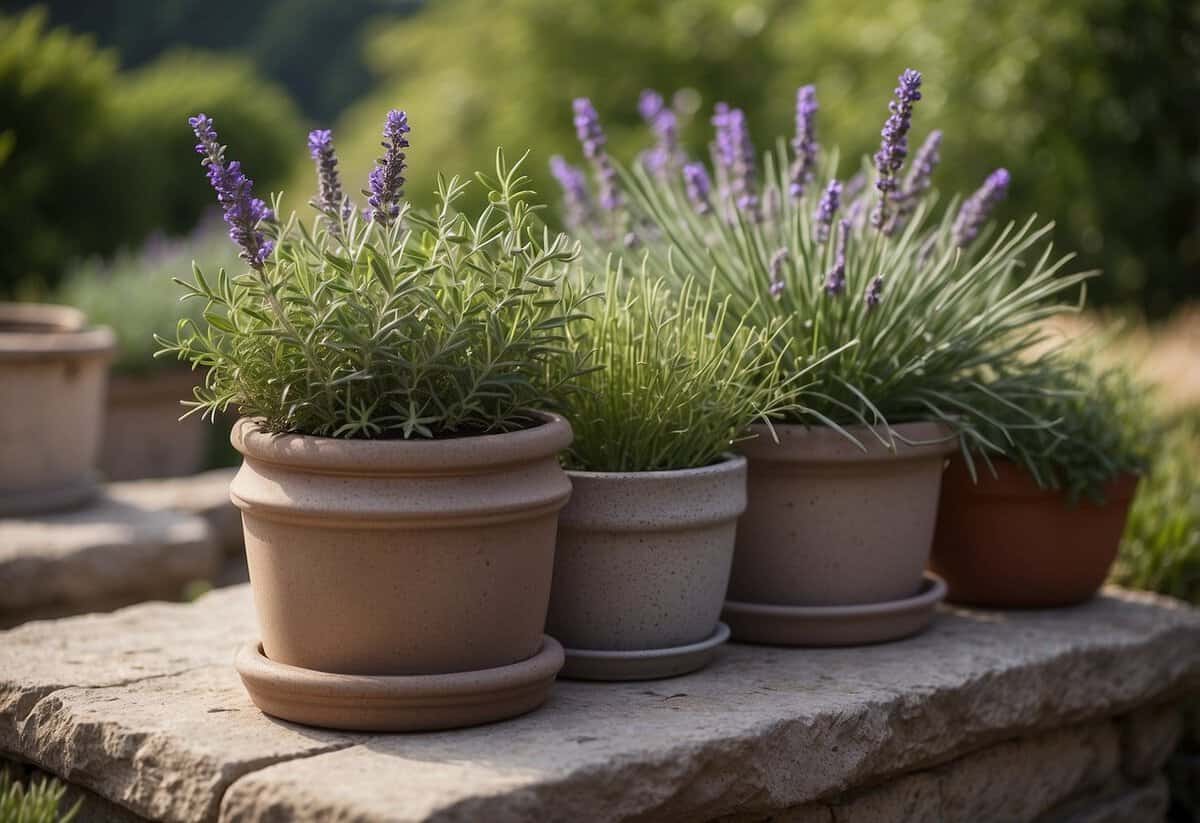
Choosing the right plants can transform your container garden into a charming French retreat. Focus on traditional French plants for an authentic feel, and consider climate-adapted choices to suit your local weather conditions.
Traditional French Plants
Traditional French gardens often feature lavender, known for its soothing fragrance and lovely purple blooms. Lavender thrives in well-drained soil and plenty of sunlight. Geraniums are another classic choice, especially vibrant varieties that add bold splashes of color to window boxes and planters. They’re ideal for zones 10-11 but can also grow as annuals in cooler areas.
Roses, particularly old-fashioned types, bring a timeless elegance with their beautiful blossoms and delightful scent. When using roses, make sure to provide ample sunlight and water while ensuring the soil drains well. Hydrangeas are known for their lush, large flowers and come in shades of blue, pink, and white. They’re perfect for adding height and texture to your garden. Lastly, lavender and sage are lovely herbs that add both color and fragrance.
Climate-Adapted Choices
Selecting plants that thrive in your specific climate will ensure your garden flourishes. If your area experiences hot, dry summers, consider rosemary and thyme. These herbs are not only useful in the kitchen but are also drought-tolerant and thrive in full sun.
In cooler regions, try ferns and hostas for lush, green foliage that adds depth to your garden containers. Ornamental grasses can also provide a graceful appearance and are adaptable to various climates. Look for species suited to your garden’s specific conditions, ensuring they receive the appropriate amount of sun or shade.
By carefully choosing plants that fit your local climate, you’ll create a sustainable and beautiful French garden that requires less maintenance while still offering plenty of charm.







